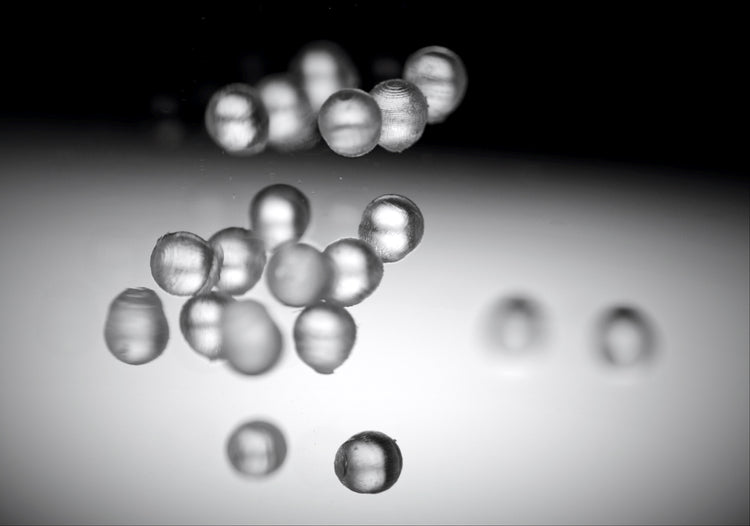L' importance de l'aérodynamisme en cyclisme ne doit pas être sous-estimée. En cyclisme professionnel, les vitesses supérieures à 40 km/h sont la norme. En contre-la-montre (CLM), les vitesses moyennes supérieures à 50 km/h sont courantes. À 40 km/h, 85 % de la puissance du cycliste est utilisée pour lutter contre la résistance aérodynamique, également appelée traînée. La résistance au roulement et mécanique ne représente que 15 %. À 50 km/h, la traînée aérodynamique représente 90 % de la puissance totale.
Il est clair que l'optimisation de la traînée aérodynamique est le principal potentiel d'augmentation de la vitesse d'un cycliste. Les combinaisons, chaussures, vélos et casques d'un cycliste sont déjà optimisés pour la traînée aérodynamique. La peau exposée constitue une zone potentiellement intéressante pour l'optimisation aérodynamique.
I. LA SCIENCE DERRIÈRE L'AÉRODYNAMIQUE EN CYCLISME

Une traînée aérodynamique [1] : Lorsque vous roulez dans l'air, votre vélo et votre corps doivent pousser l'air autour de vous. Cela crée une pression plus élevée devant vous et une pression plus faible derrière vous. De ce fait, l'air exerce une force nette contre vous lorsque vous roulez. Plusieurs facteurs déterminent la force que l'air exerce contre vous. Plus vous roulez vite, vitesse V (m/s), plus la force que l'air vous pousse et vous tire vers l'arrière est importante. Vous et votre vélo présentez une certaine surface frontale A (m²) à l'air. Plus cette surface frontale est grande, plus vous devez déplacer d'air et plus la force que l'air pousse contre vous est importante. C'est pourquoi les cyclistes et les fabricants de vélos s'efforcent de minimiser la surface frontale en position aérodynamique. La densité de l'air Rho (kg/m³) est également importante ; plus l'air est dense, plus il exerce de force sur vous.
Enfin, d'autres effets entrent en jeu, comme la douceur de vos vêtements et la fluidité de l'air autour de vous et de votre vélo, plutôt que sa turbulence. Optimiser votre position aérodynamique contribue également à cet effet. Ces autres effets sont reflétés dans un paramètre sans dimension appelé coefficient de traînée, ou Cx.
La formule de la traînée aérodynamique agissant sur un cycliste, en unités métriques, est :
F (N) = 0,5 · Cd · A · Rho · V 2
Avec A la surface frontale du cycliste en m², Rho la masse volumique de l'air en kg/m³, V la vitesse du cycliste en m/s et Cd le coefficient de traînée. La puissance P cycliste (Watt) nécessaire aux roues de votre vélo pour vaincre la force de résistance totale Fresist (N) tout en avançant à la vitesse V est :
P = F · V
avec
F (N) = F + F + F . .
La traînée F est de loin la force dominante dans cette équation. À titre d'exemple : pour un cycliste typique de 70 kg, avec un vélo de 7 kg, une surface frontale A de 0,0509 m², un coefficient de traînée Cd de 0,63, sur une pente de 0 %, avec une densité de l'air normale et une vitesse de 50 km/h, nous obtenons : traînée F = 38 N (527 W), roulement F = 3,8 N (53 W). Autrement dit, à 50 km/h, pour un cycliste en position et dans des conditions normales, près de 90 % de la puissance produite sert à vaincre la résistance de l'air.

II. CONCEPT DE GEL AÉROSPEED
Le concept NAQI Aero Speed Gel fonctionne de manière similaire aux alvéoles d'une balle de golf. En rendant rugueuse la surface d'un objet rond, on augmente la turbulence dans la couche limite. Cette turbulence accrue rend l'écoulement plus résistant à la séparation. Cette résistance permet à l'écoulement de rester plus longtemps à la surface, créant ainsi un sillage plus faible derrière l'objet. Ce sillage plus faible se traduit par une zone de pression plus faible derrière l'objet, et donc par une traînée aérodynamique plus faible.
En ajoutant des générateurs de vortex à un gel appliqué sur les bras et/ou les jambes d'un cycliste, ces particules spéciales contribuent à la génération de turbulences dans les couches limites et, par conséquent, au retardement du décollement de l'écoulement derrière les bras et/ou les jambes du cycliste. La figure 2 illustre le décollement de l'écoulement autour d'un objet sphérique avec deux points de séparation différents, indiqués par des flèches rouges.

Pour observer l'effet de la vitesse de l'air sur la turbulence, quatre vitesses d'air différentes ont été testées, toutes corrélées aux vitesses de cycle correspondantes. Les vitesses d'air en soufflerie retenues sont : 10,4, 11,8, 13,3 et 14,8 m/s. Elles correspondent à des vitesses de cycle de 37,5, 42,5, 47,9 et 53,3 km/h. La force de traînée mesurée sur le cylindre a été convertie en watts pour faciliter la comparaison.
Chaque mesure a été répétée quatre fois : deux fois avec une durée de mesure de 30 secondes et deux fois avec une durée de mesure de 60 secondes. Cela visait à vérifier la répétabilité du dispositif d'essai. La différence entre les quatre mesures était toujours inférieure à 0,1 N, ce qui prouve une excellente répétabilité.
II I. MESURE DU GEL AEROSPEED PHASE 1
Tous les essais de traînée aérodynamique ont été réalisés dans la soufflerie basse vitesse ultramoderne de Bike Valley. Les premiers prototypes ont été testés sur un cylindre enveloppé de peau de porc. La deuxième phase d'essais a été réalisée sur de vrais cyclistes.
- Configuration 1, Aero Speed Gel sur peau de porc
Pour tester un objet de référence simulant une jambe ou un bras de cycliste, un cylindre de 100 mm de diamètre a été choisi. Ce cylindre a été enveloppé de peau de porc, car celle-ci ressemble beaucoup à la peau humaine. L'objectif de ce protocole de test était d'optimiser le liquide porteur et le générateur de vortex à l'intérieur du liquide.

- Résultats de mesure
La figure 4 montre clairement que tous les prototypes de gel NAQI Aero Speed ont déjà montré une amélioration par rapport à la référence non traitée (bleu clair). Les générateurs de vortex les plus performants ont été sélectionnés pour la phase suivante de tests.

I V. AMÉLIORATION DE LA MESURE DU GEL AEROSPEED PHASE 1
A. Test du gel Aero Speed sur de vrais athlètes
La deuxième phase de tests a été menée sur de vrais cyclistes. Un cycliste a été testé en position et tenue de contre-la-montre, en tenue standard en position de cyclisme sur route, et en tenue de triathlon sur un vélo de triathlon. Cinq athlètes ont servi de sujets. Le gel a également été testé sur les bras et les jambes, en fonction de la tenue et de la discipline (contre-la-montre, route, triathlon). Pour cette phase de tests, une seule vitesse d'air a été choisie, adaptée à la discipline concernée. La vitesse d'air choisie était de 13,9 m/s (50,0 km/h) pour la position contre-la-montre, de 12,4 m/s (44,64 km/h) pour la position standard et de 10,9 m/s (39,2 km/h) pour le triathlon.
La position du cycliste devant être exactement identique, avec et sans gel, la répétabilité a également été vérifiée en effectuant chaque mesure deux fois. Dans une plage d'environ 1,5 watt, les résultats étaient bien corrélés. La position du cycliste a été vérifiée et ajustée pour que chaque mesure soit exactement identique, en traçant les contours de la position des mesures de référence devant lui. Ainsi, il pouvait vérifier et ajuster sa position pour qu'elle corresponde exactement à celle de la référence. Voir également la figure 5.
B. Résultats de mesure
En position contre-la-montre, la traînée moyenne était de 374,5 watts, sans gel aérodynamique NAQI et avec gel, de 360,5 watts. Cela donne une différence de 14 watts à la vitesse choisie, ce qui correspond à une réduction de traînée de près de 4 %. Le gain de temps sur un contre-la-montre de 9 km avec ce gel aérodynamique NAQI est de 8,4 secondes, contre 46,6 secondes sur un contre-la-montre de 50 km. Soit près d'une seconde par km. Ce résultat a été obtenu en appliquant uniquement le gel aérodynamique NAQI sur les jambes du cycliste.

Des tests similaires ont été réalisés sur un triathlète et un cycliste sur route en position et tenue normales. Pour le triathlète, la traînée moyenne de base était de 235,5 watts. La traînée avec le gel NAQI Aero Speed sur les bras, les épaules et les jambes était de 222 watts. Il peut sembler contradictoire que l'application du gel sur les bras et les jambes, et non uniquement sur les jambes, n'entraîne pas de réduction supplémentaire de la traînée. Mais rappelons que pour le triathlète, les tests ont été effectués à 39 km/h au lieu de 50 km/h.
La réduction moyenne de la traînée était de 13,5 watts. Cela représente un gain de temps de 307 secondes sur la distance Ironman, soit une réduction de la traînée de près de 6 %.
Pour une position et une tenue de course standard, la traînée de base était de 420,7 watts à 44,6 km/h. Avec le gel aérodynamique NAQI sur les jambes, la traînée a été réduite à 405,2 watts. Cela représente une réduction de près de 4 %.
V. CONCLUSION
Le gel NAQI ® Aero Speed utilise des générateurs de vortex pour amplifier les turbulences dans la couche limite du flux d'air à certains endroits du corps du cycliste. Ces turbulences accrues entraînent une séparation ultérieure du flux, un sillage plus faible et une traînée plus faible.
Des essais approfondis en soufflerie ont montré une réduction de la traînée de près de 4 % en l'appliquant uniquement sur les jambes d'un cycliste. En l'appliquant également sur les épaules et les bras d'un triathlète, une réduction de la traînée de près de 6 % a été obtenue.
RÉFÉRENCES
[ 1] Fage, A. & Warsap, JH (1930), L'effet de la turbulence et de la rugosité de surface sur la traînée d'un cylindre circulaire. Aero. Res. Com. Londres, R. & M. n° 1283.
[2] Singh, SP et Mittal, S. (2005), Écoulement au-delà d'un cylindre : instabilité de la couche de cisaillement et crise de traînée. Int. J. Numer. Meth. Fluids, 47 : 75-98. doi:10.1002/fld.807
[3] Alam, Firoz et Chowdhury, Harun et Moria, Hazim et Mazumdar, Himani et Subic, Aleksandar. (2010). Une étude expérimentale de l'aérodynamique des balles de golf. 1-4. Actes du 13e Congrès asiatique de mécanique des fluides, 17-21 décembre 2010, Dhaka, Bangladesh
[4] Traînée d'une sphère, NASA, https://www.grc.nasa.gov/www/K-12/airplane/dragsphere.html
[5] Zgoren, Muammer et Dogan, Sercan et Okbaz, Abdulkerim et Sahin, Besir et Akilli, Huseyin. (2011). Etude de la rugosité de surface de la structure d'écoulement autour d'un shere. Conférence aérospatiale internationale d'Ankara. septembre 2011
[6] Achenbach, E. (1971). Influence de la rugosité de surface sur l'écoulement transversal autour d'un cylindre circulaire. Journal of Fluid Mechanics, 46(2), 321-335.
[7] Crouch, Timothy N. ; Burton, David ; LaBry, Zach A. et Blair, Kim B. « Rouler contre le vent : une revue de l'aérodynamique du cyclisme de compétition. » Sports Engineering (mai 2017).
AUTEURS
Premier auteur – Nikolaas Van Riet, consultant en aérodynamique cycliste, ancien responsable du centre d'essais en soufflerie de Bike Valley, N ikolaas.vanriet@gmail.com
Deuxième auteur – Greet Claes, responsable de la recherche et du développement chez NAQI, G.Claes@naqi.com

